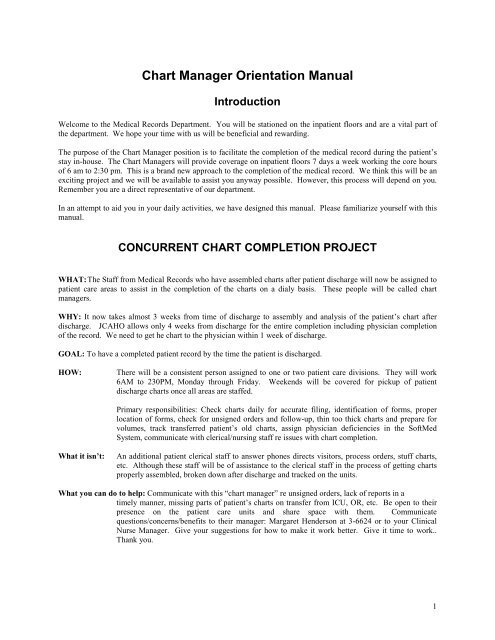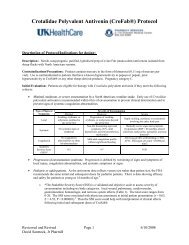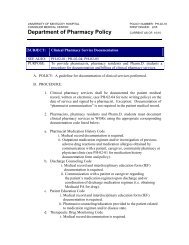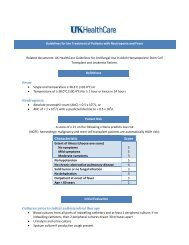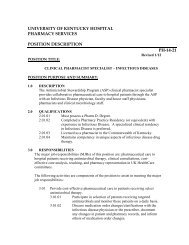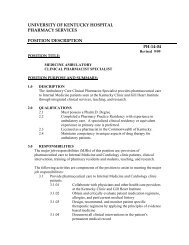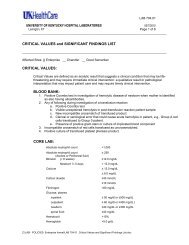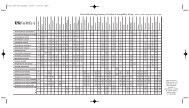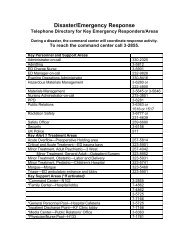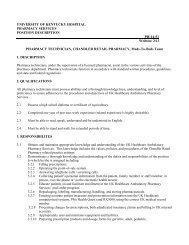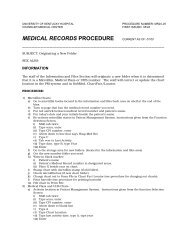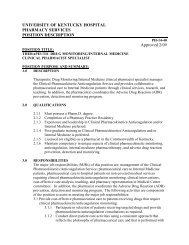Create successful ePaper yourself
Turn your PDF publications into a flip-book with our unique Google optimized e-Paper software.
<strong>Chart</strong> <strong>Manager</strong> Orientation <strong>Manual</strong>IntroductionWelcome to the Medical Records Department. You will be stationed on the inpatient floors and are a vital part ofthe department. We hope your time with us will be beneficial and rewarding.The purpose of the <strong>Chart</strong> <strong>Manager</strong> position is to facilitate the completion of the medical record during the patient’sstay in-house. The <strong>Chart</strong> <strong>Manager</strong>s will provide coverage on inpatient floors 7 days a week working the core hoursof 6 am to 2:30 pm. This is a brand new approach to the completion of the medical record. We think this will be anexciting project and we will be available to assist you anyway possible. However, this process will depend on you.Remember you are a direct representative of our department.In an attempt to aid you in your daily activities, we have designed this manual. Please familiarize yourself with thismanual.CONCURRENT CHART COMPLETION PROJECTWHAT:The Staff from Medical Records who have assembled charts after patient discharge will now be assigned topatient care areas to assist in the completion of the charts on a dialy basis. These people will be called chartmanagers.WHY: It now takes almost 3 weeks from time of discharge to assembly and analysis of the patient’s chart afterdischarge. JCAHO allows only 4 weeks from discharge for the entire completion including physician completionof the record. We need to get he chart to the physician within 1 week of discharge.GOAL: To have a completed patient record by the time the patient is discharged.HOW:There will be a consistent person assigned to one or two patient care divisions. They will work6AM to 230PM, Monday through Friday. Weekends will be covered for pickup of patientdischarge charts once all areas are staffed.Primary responsibilities: Check charts daily for accurate filing, identification of forms, properlocation of forms, check for unsigned orders and follow-up, thin too thick charts and prepare forvolumes, track transferred patient’s old charts, assign physician deficiencies in the SoftMedSystem, communicate with clerical/nursing staff re issues with chart completion.What it isn’t:An additional patient clerical staff to answer phones directs visitors, process orders, stuff charts,etc. Although these staff will be of assistance to the clerical staff in the process of getting chartsproperly assembled, broken down after discharge and tracked on the units.What you can do to help: Communicate with this “chart manager” re unsigned orders, lack of reports in atimely manner, missing parts of patient’s charts on transfer from ICU, OR, etc. Be open to theirpresence on the patient care units and share space with them. Communicatequestions/concerns/benefits to their manager: Margaret Henderson at 3-6624 or to your ClinicalNurse <strong>Manager</strong>. Give your suggestions for how to make it work better. Give it time to work..Thank you.1
1. WEEKDAY SCHEDULING AND COVERAGE:WORK ETHIC EXPECTATIONSThe Medical Records Department follows the University policies for attendance. Criteria have been established fortardiness, shift trading and unauthorized absences.a. Work Schedules:The inpatient units will be covered 7 days a week. Monday through Friday the <strong>Chart</strong> <strong>Manager</strong>s will work 6 am to2:30 pm to be on units when physicians are rounding. On the weekends, the <strong>Chart</strong> <strong>Manager</strong>s will work only ondischarged patient charts from all floors and hours may vary. Scheduled leave days such as vacation leave or sickleave need to be requested 4 weeks in advance. The supervisor of the Files Section will be responsible forscheduling the relief clerks to cover for your vacations. A supervisor must first approve all employee changes inschedule. Due to time constraints, all employees time must be reported to payroll, by the supervisors, no later than10:00 am on the Monday prior to payday.b. Arriving to Work:Each employee is expected to report to work on time. Any tardiness will be documented and deducted from the timecard. *Excessive tardiness will be grounds for disciplinary action and eventual termination. If an employee expectsto be late, he or she must call and report this possibility to the supervisor. Unusual circumstances will beconsidered, however, generally the guidelines for tardiness will be as follows; 3 occasions will warrant a verbalwarning, the 4th occasion will warrant a written warning, and the 5th occasion could result in probation, 6thoccasion suspension without pay, 7th occasion 3 day suspension, 8th occasion could result in termination. The timeframe for disciplinary action will be a 6-month period.For payroll purposes only, arrival of staff will be recorded on the basis of 15-minute periods. For example, arrivalon the 8th minute will be considered being 15 minutes late.c. Breaks:Each employee is entitled to two 15 minute breaks and an hour for lunch during their shift.2. WEEKEND SCHEDULING:The <strong>Chart</strong> <strong>Manager</strong>s will rotate weekends among the staff, both Saturday and Sunday. It should be noted that if it isyour Saturday/Sunday to work and you are ill, you would be responsible for calling the other<strong>Chart</strong> <strong>Manager</strong>s to arrange coverage for your shift. Also, you will be expected to work an additional weekend tomake up for the one you missed the next schedule.3. EMPLOYEES CALLING IN:The employee who is ill and/or expects to be absent must call his/her supervisor at least an hour before the shiftbegins so that coverage can be arranged.4. UNSCHEDULED ABSENCES:a. New Employees:(1) The first absence during the new employee’s probation period will result in a one-month extension of probation.(2) The second absence will result in a three-month extension of probation and must be supported by a physician’sstatement.(3) The third absence will result in the employee failing to pass probation, in other words, termination.2
6. COMMUNICATION:All <strong>Chart</strong> <strong>Manager</strong>s will be on E-mail to facilitate communication between the <strong>Chart</strong> <strong>Manager</strong>s and the MedicalRecord Department Supervisors.7. SUPPLIES NEEDED:After a meeting with staff in each area, space for storing supplies will be assigned. The following supplies will beneeded:a. Tacky Fingerb. Pensc. Whiteoutd. <strong>Chart</strong> flags; all colorse. Pinksf. Progress notesg. <strong>Chart</strong>sh. Roll of numbersi. Hole punchesj. Permaclipsk. Rulerl. DNR stickersm. Yellow dividersn. Blue dividerso. Green dividersREGULAR CHARTS:ANALYZING INSTRUCTIONS1. The discharging resident dictates discharge Summary.2. Must have daily note from service of which the patient is admitted or transferred. Can be written by resident orattending. If you need a daily note written, ask a resident to write you’re not except in neonatal charts.3. The attending physician must co-sign or write one daily note each day of the admission except for the first day.4. Pre-anesthesia notes (blue sheet) must be completed and co-signed by the anesthesia attending or the attendingmay write their own note on the back of the blue sheet.5. Post-anesthesia record most be completed on the back of the blue sheet if there is no post-anesthesia not on theback of the Operative Note/Histopathology Report.6. The general anesthesia record must be signed by the anesthesia attending.7. The attending physician must sign operative procedure notes.8. The attending physician and the anesthesia attending must sign Operating Room Patient Record.9. Post-anesthesia note must be completed and signed by the anesthesia attending or resident.10. Operative Report is usually dictated by the resident, but must be signed by the attending.11. All physician order must be signed. If you can’t read the signature or it contains no beeper number give it to theattending physician to sign.12. A resident or an attending must cosign all student and acting interns (AI) progress notes, physician orders, etc.6
13. All Nurse Practitioners, ARNP’s, PA’s and midwife notes do not need cosigning except if you need anattending for that day.OB CHARTS:1. Discharge Summary will not have to be dictated if the admission is a normal delivery with no complication andthe record is accompanied with a completed OB Discharge Summary. If there is no OB Discharge SummaryForm in the chart or it is blank; the resident on the case will be asked to dictate. A normal stay is usually 5 daysor less. C-sections, tubals, and OB undelivered must have a dictated discharge summary.2. OB Summary Sheet must be completed and signed. The discharging attending must co-sign this form.3. Daily notes must be written and an attending must co-sign all daily notes. When needing daily notes co-signeduse the OB Schedule. Your L&D physician will be the physician who needs to co-sign your notes.4. OR Section needs to be analyzed the same as regular charts.5. All physician orders must be signed.NEWBORN CHARTS:1. Discharge summary for routine newborn stays (less than 5 days) with no complications does not need to bedictated.2. Newborn Progress Notes/Discharge Assessment Sheet must be completed and the attending must co-sign it.3. Daily notes-the only progress note that is required is a circumcision note if the infant is a boy.4. The Newborn Summary Sheet is signed by the attending and is therefore considered an attending note.5. All physician orders must be signed.NEONATAL CHARTS:1. Discharge Summary must be dictated.2. Daily notes must be written everyday of the admission, if a note is not written ask the attending to write themissing note.3. An attending must co-sign or write a note for each day of the admission except for the first day.4. OR section is analyzed the same as for regular charts.5. All physician orders must be signed.OBSERVATION CHARTS:Discharge Summary must be dictated.OUTPATIENT SURGERY CHARTS:1. OR section must be completed.2. The resident must dictate operative report or attending if no resident listed.7


